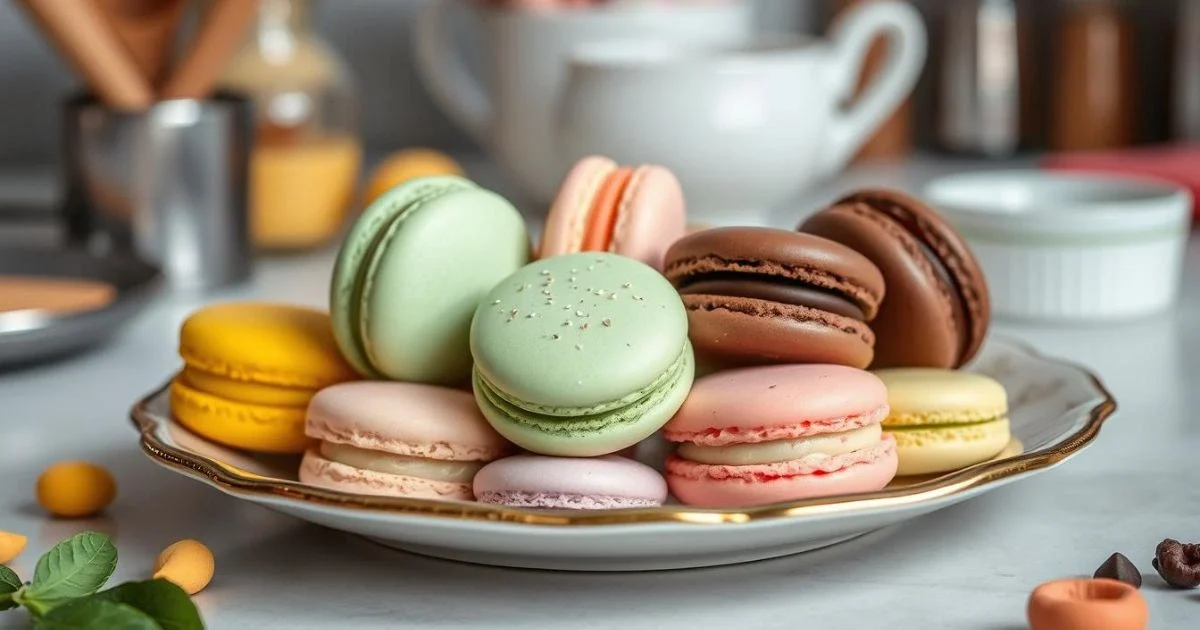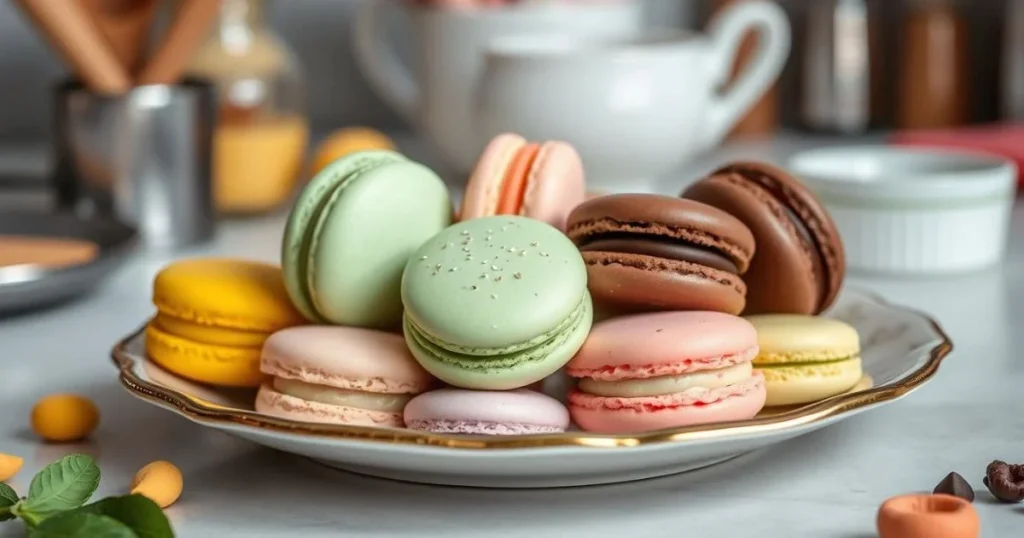Introduction
If you’ve ever walked by a French bakery and admired the array of delicate, colorful macarons displayed in the window, you’re not alone. French macarons are not only visually stunning, but they also melt in your mouth with a delightful combination of crisp and chewy textures. Their perfectly smooth tops and the airy sweetness inside make them a favorite among pastry lovers worldwide. Despite their luxurious appearance, these delicate cookies can be made right at home with the right guidance.
This French Macarons Recipe will walk you through each step with easy-to-follow instructions, ensuring that even first-time bakers can achieve impressive results. Whether you’re looking to impress your friends or indulge yourself with this classic French treat, this recipe will guide you through the process, from mixing the batter to piping perfect macarons.
The Story Behind French Macarons Recipe
French Macarons Recipe are often associated with Parisian patisseries, but did you know that these delectable treats actually have Italian roots? That’s right! The history of macarons can be traced back to the Renaissance era, where they were introduced in France by the Italian chef of Queen Catherine de’ Medici. Originally, macarons were simpler almond-based cookies. It wasn’t until the 20th century that the macaron as we know it today, with its two almond meringue cookies filled with ganache, buttercream, or jam, became popular thanks to French pâtissier Pierre Desfontaines of the Ladurée brand. French Macarons Recipe
This interesting origin adds to the allure of these delicate treats. Macarons have become synonymous with elegance, sophistication, and a touch of indulgence. Now, you can create this piece of culinary history in your own kitchen.
Why You’ll Love This French Macarons Recipe
Making macarons at home may seem intimidating, but trust me—it’s entirely doable. Yes, macarons are a bit finicky, but with a little patience and precision, you can achieve bakery-quality results right in your kitchen. What makes this French Macarons Recipe truly stand out is that it simplifies the complex steps while maintaining the authenticity of this beloved treat. The recipe ensures a perfect balance between the crisp shell and the soft, chewy interior, and the variety of filling options means you can tailor it to your personal taste. French Macarons Recipe
By following this detailed guide, you’ll not only learn how to make French Macarons Recipe but also discover some helpful tips and tricks to master the technique. From understanding the importance of “macaronage” (the process of mixing the batter to the perfect consistency) to troubleshooting common issues like cracked tops or hollow shells, this recipe covers it all. French Macarons Recipe
Now, let’s dive into the recipe!
French Macarons Recipe
Description
A delicate, crisp, and chewy French Macarons Recipe made from almond flour and meringue, filled with your choice of buttercream, ganache, or jam. Ideal for any celebration or simply as a delightful treat.
Prep time: 30 minutes
Cooking time: 15 minutes
Total time: 1 hour 45 minutes (including cooling time)
Calories: 100 calories per macaron
Ingredients
For the Macaron Shells:
- 1 cup almond flour (finely ground and sifted)
- 1 3/4 cup powdered sugar
- 3 large egg whites (room temperature)
- 1/4 cup granulated sugar
- Pinch of cream of tartar
- Gel food coloring (optional)
- 1/2 teaspoon vanilla extract (optional)
For the Buttercream Filling (Optional):
- 1/2 cup unsalted butter, softened
- 1 1/2 cups powdered sugar
- 2 tablespoons heavy cream
- 1 teaspoon vanilla extract (or any flavor of your choice)
- Pinch of salt
For Ganache Filling (Optional):
- 1/2 cup heavy cream
- 1/2 cup dark chocolate (chopped)
For Jam Filling (Optional):
- 1/4 cup of your favorite fruit jam (such as raspberry, strawberry, or apricot)
Instructions
1. Preparing the Almond Flour Mixture:
- Sift the almond flour and powdered sugar together into a large mixing bowl. This step is crucial to ensure a smooth, lump-free batter. If there are any large bits left in the sifter, discard them.
- Set this dry mixture aside.
2. Making the Meringue:
- In a clean, dry mixing bowl, beat the egg whites with an electric mixer or stand mixer on medium speed until foamy.
- Incorporate the cream of tartar and keep mixing until soft peaks begin to form.
- Gradually add the granulated sugar, a little at a time, while continuing to beat the egg whites on medium-high speed. Beat until stiff, glossy peaks form. This is when the meringue holds its shape when you lift the beaters.
- If you want colored macarons, this is the time to add a few drops of gel food coloring. Make sure to use gel, as liquid food coloring can affect the consistency of the batter.
3. Macaronage (Mixing the Batter):
- Gently fold the almond flour mixture into the meringue using a silicone spatula. The goal is to deflate the meringue just enough so that the batter flows like lava when dropped from the spatula. This process is called “macaronage.”
- Be careful not to overmix, as this can lead to runny batter, but also avoid undermixing, which can cause your macarons to crack or rise unevenly. Aim for a smooth, ribbon-like consistency.
4. Piping the Macarons:
- Place parchment paper or silicone mats on two baking sheets
- Spoon the batter into a piping bag fitted with a round nozzle (approximately 1/2 inch in diameter).
- Pipe small circles (about 1 1/2 inches in diameter) onto the prepared baking sheets, spacing them about an inch apart.
- After piping, tap the baking sheets on the counter a few times to release any trapped air bubbles. If any air bubbles remain, pop them with a toothpick.
5. Resting the Macarons:
- Allow the piped macarons to rest at room temperature for 30-60 minutes, or until the tops are no longer sticky when gently touched. This drying process helps form the signature “feet” during baking.
6. Baking:
- Preheat your oven to 300°F (150°C).
- Bake the macarons, one sheet at a time, for 14-16 minutes. The macarons are done when they develop their iconic “feet” and the tops are firm to the touch but still slightly soft inside.
- Let the macarons cool completely on the baking sheets before attempting to remove them.
7. Making the Filling:
- Buttercream: Beat the softened butter until creamy, then gradually add the powdered sugar, heavy cream, vanilla extract, and salt. Mix until smooth and fluffy.
- Ganache: Heat the heavy cream in a small saucepan over medium heat until it just begins to simmer. Pour the hot cream over the chopped chocolate and let sit for a minute, then stir until smooth. Allow the ganache to cool slightly before using.
- Jam: Simply use your favorite jam or jelly for a fruity filling.
8. Assembling the Macarons:
- Once the shells have cooled completely, pair them up by size.
- Pipe or spoon your chosen filling onto the flat side of one shell, then gently press another shell on top to create a sandwich.
9. Maturing the Macarons:
- For best results, place the assembled macarons in an airtight container in the refrigerator for 24-48 hours. This process, known as “maturing,” allows the flavors to meld and improves the texture.
Notes
- Humidity Warning: Macarons can be particularly sensitive to humidity. If you live in a humid climate, you may need to extend the drying time before baking.
- Filling Variations: Feel free to experiment with different fillings. Lemon curd, salted caramel, or pistachio cream are great alternatives.
- Storage: Macarons can be stored in the fridge for up to 5 days or frozen for up to a month.
Nutrition Information (Per Macaron)
- Calories: 100
- Fat: 5g
- Carbohydrates: 12g
- Protein: 2g
- Sugars: 10g
Conclusion
Making French macarons at home may seem like a daunting task, but with patience, precision, and this detailed French Macarons Recipe, you’ll be on your way to creating these elegant treats right in your own kitchen. While the process does require a bit of practice, the reward is well worth the effort. From mastering the art of macaronage to customizing the fillings to your liking, this recipe is a fantastic starting point for both novice bakers and experienced pastry lovers alike. French Macarons Recipe
Whether you’re crafting them for a special occasion or simply indulging in a sweet treat, homemade macarons are sure to impress. Remember, don’t be discouraged by any early mishaps—each batch brings you closer to mastering this delightful French delicacy. So, gather your ingredients, follow the steps carefully, and enjoy the sweet satisfaction of biting into a perfectly crisp and chewy macaron! French Macarons Recipe
FAQ
Easy French Macarons Recipe: Perfect Every Time
Course: DessertsCuisine: FrenchDifficulty: Medium24
macarons45
minutes18
minutes180
kcalThese delicate French macarons feature a crisp shell with a chewy center, filled with your favorite creamy filling. A perfect treat for any occasion!
Ingredients
1 cup powdered sugar
1 cup almond flour
3 large egg whites (at room temperature)
¼ cup granulated sugar
½ tsp vanilla extract
¼ tsp cream of tartar
Your favorite filling (buttercream, ganache, or jam)
Directions
- Prep the Ingredients:
Sift the powdered sugar and almond flour together in a bowl to remove any lumps. - Whip Egg Whites:
In a clean bowl, beat egg whites with a hand mixer until soft peaks form. Add cream of tartar and gradually add the granulated sugar. Continue to beat until stiff peaks form. - Fold Dry Ingredients:
Gently fold the sifted almond flour and powdered sugar mixture into the whipped egg whites using a spatula. The mixture should be smooth and slightly thick. - Pipe the Macarons:
Transfer the batter into a piping bag fitted with a round tip. Pipe 1-inch circles onto a parchment-lined baking sheet, leaving space between each one. - Rest the Macarons:
Let the piped macarons rest at room temperature for 30 minutes, until they form a skin and are no longer sticky to the touch. - Bake:
Preheat the oven to 300°F (150°C). Bake the macarons for 15-18 minutes, rotating the sheet halfway through. They should have a firm shell and slightly lift from the parchment paper. - Cool and Fill:
Let the macarons cool completely on the sheet before gently removing them. Pair similar-sized macarons and fill with your desired filling.
Notes
- Room Temperature Egg Whites: For best results, make sure your egg whites are at room temperature. This helps them whip to a better volume.
Resting Time: Don’t skip the resting time before baking. This helps form the signature “foot” of the macaron and ensures they bake properly.
Almond Flour: Make sure to use finely ground almond flour for the best texture. Avoid almond meal, which can be too coarse.
Baking: Macarons are sensitive to oven temperature. Consider using an oven thermometer to ensure the correct temperature, and rotate the tray halfway through to prevent uneven baking.
Storage: Store macarons in an airtight container at room temperature for up to 3 days or refrigerate for longer storage.


